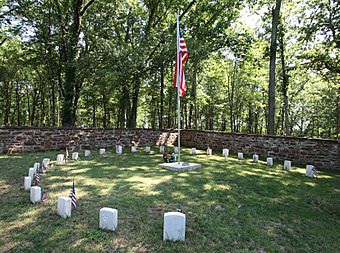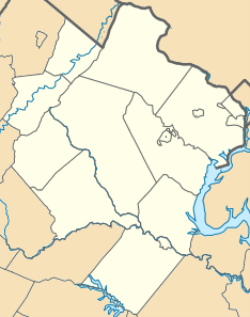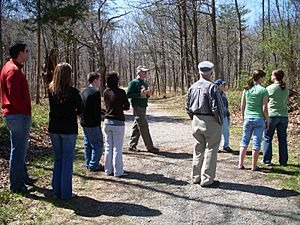Ball's Bluff Battlefield and National Cemetery facts for kids
|
Ball's Bluff Battlefield and National Cemetery
|
|

The circle of 25 graves at Ball's Bluff
|
|
| Location | Loudoun County, Virginia, US |
|---|---|
| Nearest city | Leesburg, Virginia |
| Area | 76 acres (31 ha) |
| NRHP reference No. | 84003880 |
Quick facts for kids Significant dates |
|
| Added to NRHP | April 27, 1984 |
| Designated NHLD | April 27, 1984 |
Ball's Bluff Battlefield Regional Park and National Cemetery is a historic site in Loudoun County, Virginia. It is about 2 miles (3.2 km) northeast of Leesburg, Virginia. This area includes a battlefield and a United States National Cemetery.
The cemetery is one of the smallest national cemeteries in the United States. It holds the graves of 54 Union Army soldiers. These soldiers died during the Battle of Ball's Bluff. They are buried in 25 graves within a half-acre plot. Most of the soldiers buried here are unknown. Only one, James Allen of the 15th Massachusetts, has been identified.
Near the cemetery, there are monuments for fallen soldiers. One is for Confederate Sergeant Clinton Hatcher. Another is for Union commander Edward Dickinson Baker. Neither of these men are buried at this cemetery. The cemetery itself is managed by the United States Department of Veterans Affairs. The larger 223-acre (0.9 km²) park is managed by the Northern Virginia Regional Park Authority.
Contents
The Battle of Ball's Bluff
The Battle of Ball's Bluff was a small but important battle. It happened early in the American Civil War. This defeat for the Union Army came just months after other losses. These included the First Battle of Bull Run and the Battle of Wilson's Creek. The Union's defeat at Ball's Bluff showed problems with how officers were chosen. It also led to the creation of a special committee in Congress. This committee was called the United States Congress Joint Committee on the Conduct of the War.
Union Plans and Confederate Response
On October 21, 1861, Union Colonel Edward Dickinson Baker received orders. Colonel Baker was a U.S. Senator from Oregon. He was also a close friend of President Abraham Lincoln. His orders came from Brigadier General Charles Pomeroy Stone.
Baker was told to either pull back Union troops already in Virginia. These troops were on the Virginia side of the Potomac River. They were there to check on a Confederate camp. Or, he could send more troops if the mission was going well.
Before Baker could figure out what was happening, Confederate guards saw the Union force. Local Confederate commander Colonel Nathan George Evans quickly sent his soldiers. He deployed regiments from Virginia and Mississippi to meet the threat. He also kept some defenses ready for a larger Union crossing.
The Fight at the Bluff
Colonel Baker sent more companies of Union soldiers across the river. But he placed his troops in a bad spot. The tall bluff was behind them. Higher ground was in front of their lines. This made it hard for them to fight effectively.
The battle lasted a long time. The Confederate pressure eventually broke the Union line. The Union troops were pushed down the steep hill towards the river. Many soldiers were killed or wounded. Colonel Baker was killed, along with 222 other Union soldiers. Another 226 were wounded, and 553 were captured.
There were only a few boats available to cross the river. These boats quickly became too full. Some even flipped over because of too many people. This made it impossible to get everyone out. Some soldiers swam to nearby Harrison Island. But 161 soldiers went missing. Many of them drowned in the swollen Potomac River. For days after the battle, bodies of Union soldiers floated downstream towards Washington, D.C.
After the Battle
News of Colonel Baker's death shocked Washington, D.C. He was a senator and a friend of President Lincoln. When Congress met in December, people spoke for days about his death.
A special group was formed to investigate the recent defeats. This group was called the United States Congress Joint Committee on the Conduct of the War. They looked into why the Union lost battles, especially Baker's death. These kinds of investigations were new at the time. The committee's work caused problems throughout the war. It also ended the career of General Stone. He was blamed for Baker's defeat at Ball's Bluff. The main commander, Army of the Potomac General George B. McClellan, was not blamed. He had given vague orders that started the whole event.
Visiting the Battlefield and Cemetery
The land for the cemetery was given in 1865. The battlefield area was named a National Historic Landmark in 1984. This means it is a very important historical site. At that time, the 300-foot (91 m) tall bluff and the river landing looked much the same. They were like they were 123 years earlier during the battle.
The Ball's Bluff National Cemetery is enclosed by a stone wall. It holds the graves of 54 Union soldiers. As mentioned, 53 of them are unknown. Only James Allen of the 15th Massachusetts Infantry is identified. There is also a fenced 1.3-mile (2.1 km) road built in 1907. Nearby, you can find a marker for Confederate soldier Clinton Hatcher. He was from the 8th Virginia Infantry. There is also a marker where Colonel Baker was killed.
The regional park is managed by the Northern Virginia Regional Park Authority. It has over seven miles (11 km) of marked trails. This includes a mile-long loop trail that goes to the bluff overlook. This trail has signs that explain the history. There is also a 2.1-mile (3.4 km) trail along the Potomac riverbank.
See also





